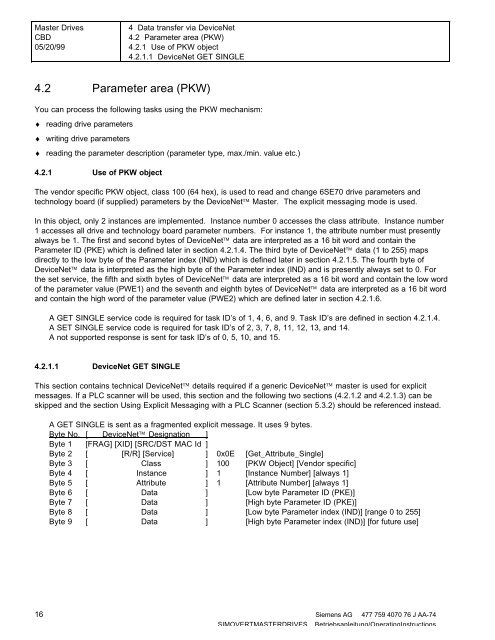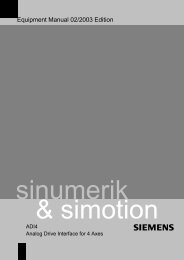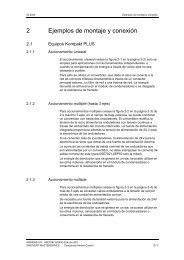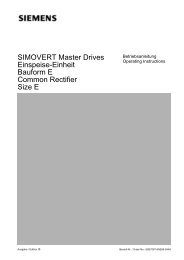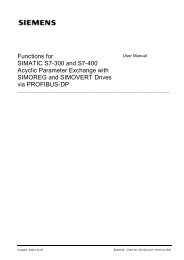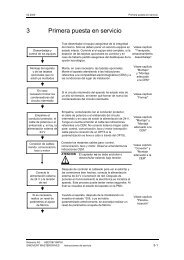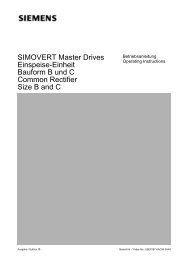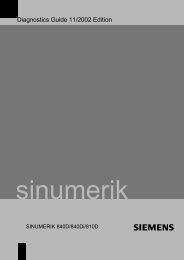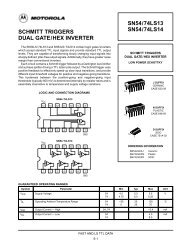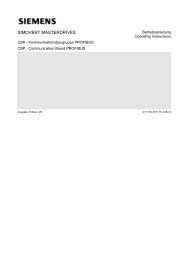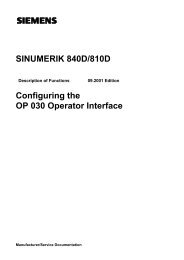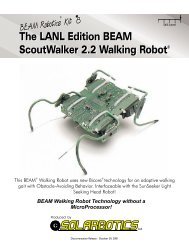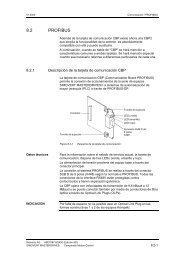SIMOVERT Master Drives Communication Board CBD
SIMOVERT Master Drives Communication Board CBD
SIMOVERT Master Drives Communication Board CBD
- No tags were found...
Create successful ePaper yourself
Turn your PDF publications into a flip-book with our unique Google optimized e-Paper software.
<strong>Master</strong> <strong>Drives</strong><strong>CBD</strong>05/20/994 Data transfer via DeviceNet4.2 Parameter area (PKW)4.2.1 Use of PKW object4.2.1.1 DeviceNet GET SINGLE4.2 Parameter area (PKW)You can process the following tasks using the PKW mechanism:♦ reading drive parameters♦ writing drive parameters♦ reading the parameter description (parameter type, max./min. value etc.)4.2.1 Use of PKW objectThe vendor specific PKW object, class 100 (64 hex), is used to read and change 6SE70 drive parameters andtechnology board (if supplied) parameters by the DeviceNet <strong>Master</strong>. The explicit messaging mode is used.In this object, only 2 instances are implemented. Instance number 0 accesses the class attribute. Instance number1 accesses all drive and technology board parameter numbers. For instance 1, the attribute number must presentlyalways be 1. The first and second bytes of DeviceNet data are interpreted as a 16 bit word and contain theParameter ID (PKE) which is defined later in section 4.2.1.4. The third byte of DeviceNet data (1 to 255) mapsdirectly to the low byte of the Parameter index (IND) which is defined later in section 4.2.1.5. The fourth byte ofDeviceNet data is interpreted as the high byte of the Parameter index (IND) and is presently always set to 0. Forthe set service, the fifth and sixth bytes of DeviceNet data are interpreted as a 16 bit word and contain the low wordof the parameter value (PWE1) and the seventh and eighth bytes of DeviceNet data are interpreted as a 16 bit wordand contain the high word of the parameter value (PWE2) which are defined later in section 4.2.1.6.A GET SINGLE service code is required for task ID’s of 1, 4, 6, and 9. Task ID’s are defined in section 4.2.1.4.A SET SINGLE service code is required for task ID’s of 2, 3, 7, 8, 11, 12, 13, and 14.A not supported response is sent for task ID’s of 0, 5, 10, and 15.4.2.1.1 DeviceNet GET SINGLEThis section contains technical DeviceNet details required if a generic DeviceNet master is used for explicitmessages. If a PLC scanner will be used, this section and the following two sections (4.2.1.2 and 4.2.1.3) can beskipped and the section Using Explicit Messaging with a PLC Scanner (section 5.3.2) should be referenced instead.A GET SINGLE is sent as a fragmented explicit message. It uses 9 bytes.Byte No. [ DeviceNet Designation ]Byte 1 [FRAG] [XID] [SRC/DST MAC Id ]Byte 2 [ [R/R] [Service] ] 0x0E [Get_Attribute_Single]Byte 3 [ Class ] 100 [PKW Object] [Vendor specific]Byte 4 [ Instance ] 1 [Instance Number] [always 1]Byte 5 [ Attribute ] 1 [Attribute Number] [always 1]Byte 6 [ Data ] [Low byte Parameter ID (PKE)]Byte 7 [ Data ] [High byte Parameter ID (PKE)]Byte 8 [ Data ] [Low byte Parameter index (IND)] [range 0 to 255]Byte 9 [ Data ] [High byte Parameter index (IND)] [for future use]16 Siemens AG 477 759 4070 76 J AA-74<strong>SIMOVERT</strong>MASTERDRIVES Betriebsanleitung/OperatingInstructions


